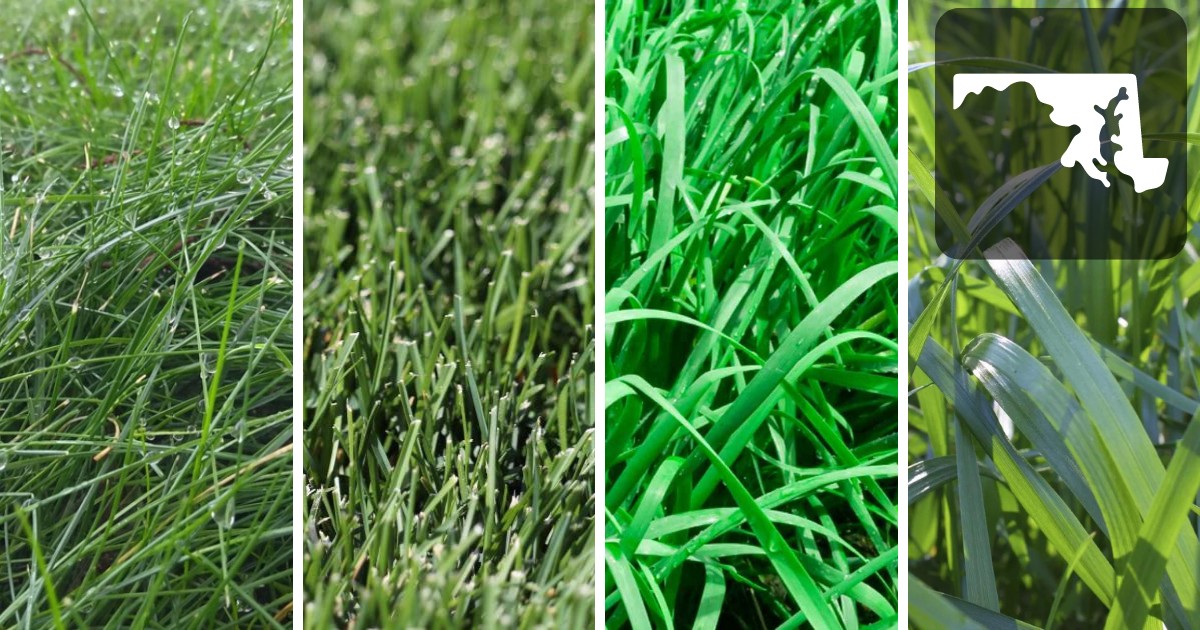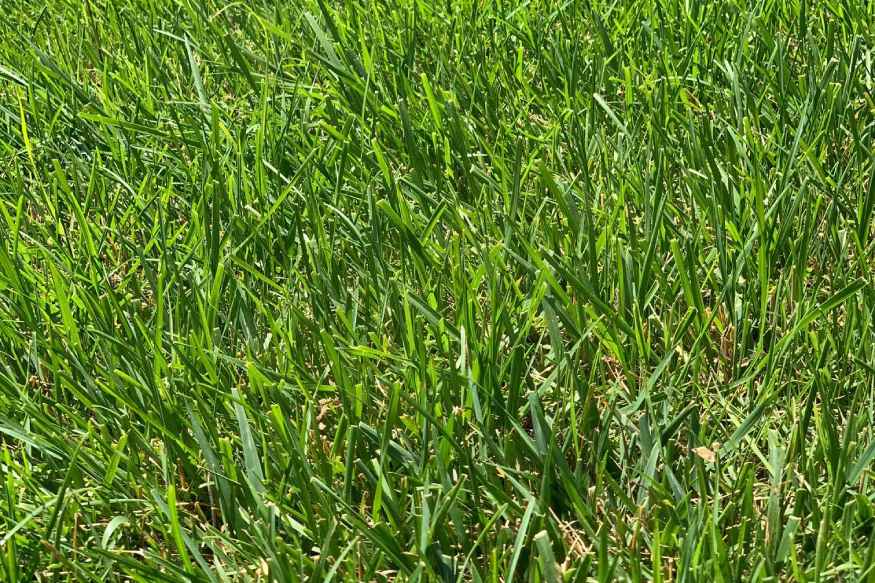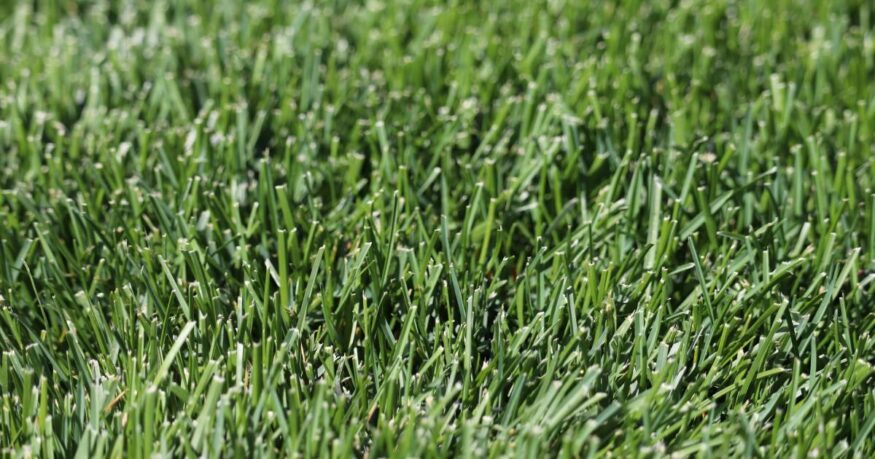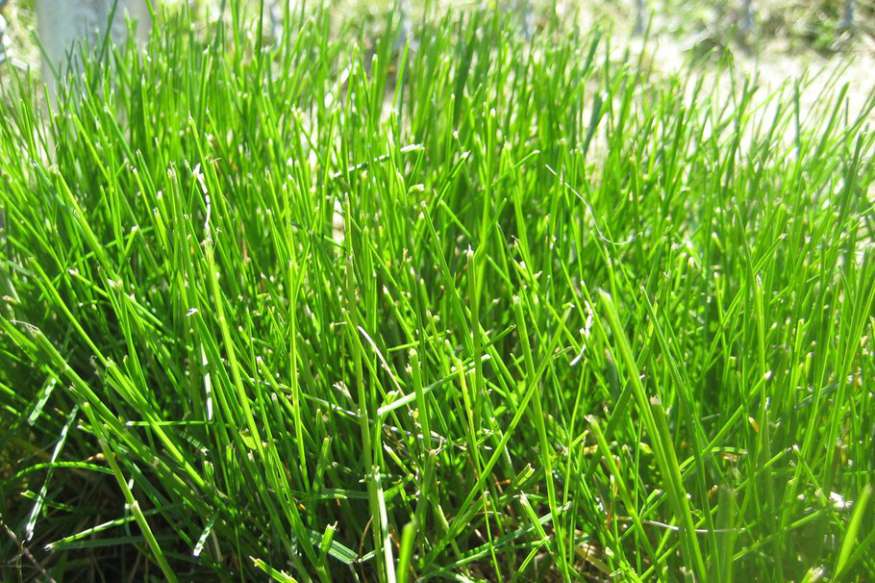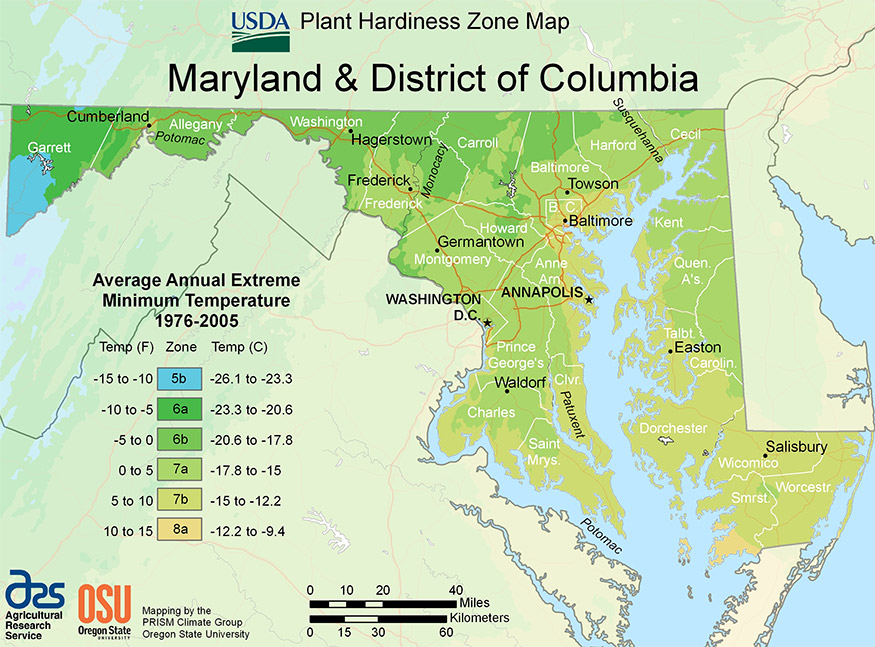Which is the best grass seed for Maryland is a question that doesn’t always have an easy answer. Maryland comes with some challenges for lawn lovers like the hot and humid summers and cold winters, as well as the frequent drought conditions.
While Tall Fescue is a great option for most homeowners, it’s important to explore all of the available grass seed options to find the one that works best for your specific needs.
In this article, we’ll take a closer look at the various types of grass seed that thrive in Maryland and help you determine which one is right for you.
[ez-toc]
Tall Fescue
| Also Known As | Lolium arundinaceum (formerly Festuca arundinacea) |
| Type of Grass | Cool season perennial |
| Optimal Zones | Northern through transition zones |
| Root Structure | Deep |
| Winter hardiness | Excellent |
| Shade tolerance | High |
| Water Requirements | Medium to High |
| Drought Tolerance | Excellent |
| Self Repair Capacity | Limited |
| Overall Maintenance Requirements | Low |
Why Tall fescue is The Most Popular Choice For Maryland
Tall fescue is the go-to choice for Maryland homeowners looking to cultivate a healthy and hardy lawn. This versatile grass has many benefits, including its ability to withstand wear and tear, as well as its heat, drought, and shade-tolerance. Compared to other grasses, tall fescue requires less maintenance and won’t turn brown as quickly during the hot summers in Maryland.
One of the reasons why tall fescue is such a popular choice is its disease resistance and low maintenance requirements. Even in the often-challenging Maryland climate, this grass maintains its green color throughout the summer months, making it a popular choice for those living in the southern part of the state.
Tall fescue is also an excellent option for athletic fields, golf courses, and other high-traffic areas due to its excellent foot traffic and wear and tear tolerance.
Although it may take a bit longer to establish, the new turf-type tall fescues are an exceptional choice for Maryland lawns. These clump-type grasses are highly wear-resistant and can handle drought, heat, and increased levels of salt in the soil. They are also moderately shade-tolerant and have few disease problems, making them an excellent low-maintenance choice.
Looking for the best grass seed for your region?
Our smart lawn plans are designed to work perfectly with your local soil and climate conditions, without any of the toxic stuff.
Use the code EHG20 for an instant $20 discount!
- Personalized lawn care: Custom lawn plans based on soil analysis, climate data, and your specific lawn needs.
- Convenience with a conscience: Products that are not only easy to use but also safe for you, your pets, and the planet.
- Science-backed formulas: Bio-based formulas contain effective, natural ingredients like seaweed, molasses, and iron.
- Expert support: Get one-on-one guidance from a real person and rest easy with Sunday's satisfaction guarantee.
Kentucky Bluegrass
| Also Known As | Poa pratensis L. |
| Type of Grass | Cool season perennial |
| Optimal Zones | Northern cool season zone, transition zones |
| Root Structure | Shallow |
| Winter hardiness | Excellent |
| Shade tolerance | Poor to Good |
| Water Requirements | High |
| Drought Tolerance | Poor |
| Self Repair Capacity | Excellent |
| Overall Maintenance Requirements | High |
What Makes Kentucky Bluegrass A Great Grass For Maryland
While Kentucky bluegrass can be a good choice for a Maryland lawn, it requires more maintenance than other grass types and is susceptible to pests and disease.
This grass reproduces vegetatively, which allows bald patches in the lawn to regrow from underground roots. However, Kentucky bluegrass suffers from heat and drought, has a tendency to thatch, and is intolerant of shade or salt.
But despite these downsides, Kentucky bluegrass is still a popular choice for residential lawns, athletic fields, and parks due to its high traffic tolerance, quick recovery, and cold tolerance. It’s important to note, though, that this grass prefers full sun and well-draining soil, making it unsuitable for areas with heavy shade or poor drainage.
If you’re considering planting Kentucky bluegrass, be prepared to put in a moderate amount of maintenance work, including frequent watering due to its shallow root system. The recommended mowing height for Kentucky bluegrass is between 2½ and 3 inches.
Overall, while Kentucky bluegrass can be a great choice for certain Maryland homeowners, it may not be the best choice for everyone. It’s important to consider your specific location, growing conditions, and maintenance capabilities before deciding on the best grass type for your lawn.
The Fine Fescues
| Also Known As | Hard fescue, strong creeping red fescue, slender creeping red fescue, sheep fescue, chewings fescue; Festuca L. |
| Type of Grass | Cool season perennial |
| Optimal Zones | Northern zones |
| Root Structure | Medium |
| Winter hardiness | Excellent |
| Shade tolerance | Excellent |
| Water Requirements | Medium to High |
| Drought Tolerance | Excellent |
| Self Repair Capacity | Limited |
| Overall Maintenance Requirements | Low |
Why Fine Fescue Grows well in Maryland
Fine fescue is an excellent choice for Maryland lawns, especially for properties with lots of shade or difficult soil conditions like clay. What makes fine fescue so great is its ability to grow in the shade, low maintenance needs, and its ability to fill in bald spots with rhizomes.
While fine fescue doesn’t tolerate heavy foot traffic, it is drought-tolerant and recovers quickly after dormancy. With its narrow, needle-like leaf blade, fine fescue has an unmistakable appearance that sets it apart from other grass types.
One of the most significant benefits of fine fescue is its ability to withstand fluctuations in temperature and high soil pH. This makes it a resilient choice for homeowners who want a low-maintenance lawn that can handle a variety of conditions. However, it’s important to note that fine fescue can be challenging to mow due to its fine texture.
If you’re looking for a grass type that can handle shade, difficult soil, and low maintenance needs, fine fescue may be the perfect choice for your Maryland lawn. Just keep in mind that it may not be the best option if you have heavy foot traffic or need a grass type that looks nice and neat after mowing.
Maryland Climate And Growing Challenges For Lawns
Maryland’s climate can be described as humid subtropical, with hot summers and mild winters. This means that the state experiences a range of temperatures and precipitation throughout the year, making it important to choose the right grass type for your lawn.
Weather
The state of Maryland experiences a variety of weather conditions that can impact the growth of your lawn. Summers can be hot and humid, while winters can be mild but with occasional bouts of cold weather.
This means that the grass type you choose must be able to withstand temperature fluctuations and drought conditions.
Soil Conditions
Maryland’s soil can also present challenges for growing a healthy lawn. Many areas of the state have heavy clay soil, which can be difficult for water and nutrients to penetrate and make it harder for grass to get a good foothold. This can also lead to poor drainage and can impact the growth of your grass. Other areas may have sandy soil, which can cause issues with water retention.
Other Challenges
Maryland lawns may also face challenges with pests, diseases, and weeds. It’s important to do some research and choose a grass type that is resistant to common pests and diseases in your area.
Looking for the best grass seed for your region?
Our smart lawn plans are designed to work perfectly with your local soil and climate conditions, without any of the toxic stuff.
Use the code EHG20 for an instant $20 discount!
- Personalized lawn care: Custom lawn plans based on soil analysis, climate data, and your specific lawn needs.
- Convenience with a conscience: Products that are not only easy to use but also safe for you, your pets, and the planet.
- Science-backed formulas: Bio-based formulas contain effective, natural ingredients like seaweed, molasses, and iron.
- Expert support: Get one-on-one guidance from a real person and rest easy with Sunday's satisfaction guarantee.
Frequently Asked Questions
What is the best grass seed for Maryland lawns?
The best grass seed for Maryland lawns depends on several factors such as soil type, climate, and intended use. However, Tall Fescue is a popular choice due to its wear-, heat-, and drought-tolerance.
What type of grass seed grows well in Maryland’s climate?
Maryland has a humid subtropical climate with hot summers and cold winters. Cool-season grasses like Tall Fescue, Kentucky Bluegrass, and Fine Fescue tend to do well in this climate.
How often should I water my grass in Maryland?
During the hot summer months in Maryland, grass should be watered deeply once or twice a week. In general, lawns need about 1 inch of water per week to thrive.
Can I use grass seed mixtures in Maryland?
Yes, grass seed mixtures are a good option for Maryland lawns as they provide a blend of grass types that can handle different growing conditions. Look for mixtures that include Tall Fescue, Kentucky Bluegrass, and Fine Fescue.
How do I choose the best grass seed for my lawn in Maryland?
Consider factors such as soil type, climate, intended use, and maintenance requirements when choosing the best grass seed for your lawn in Maryland. Consult with a local expert like a professional landscaper or horticulturist for specific recommendations.
What is the best time to plant grass seed in Maryland?
Fall is the best time to plant grass seed in Maryland as the cooler temperatures and increased rainfall provide ideal growing conditions. Spring is also an option, but the risk of drought and weed competition is higher.
What are some common lawn problems in Maryland?
Common lawn problems in Maryland include crabgrass, brown patches, and grubs. Proper lawn maintenance practices like regular mowing, watering, and fertilizing can help prevent and treat these issues.
